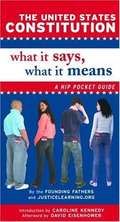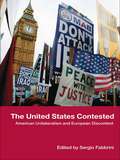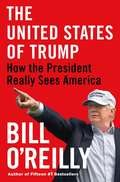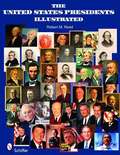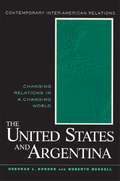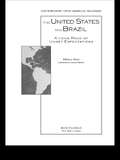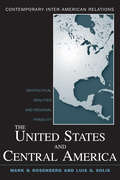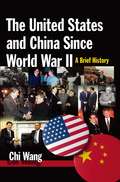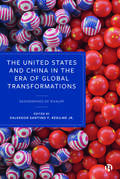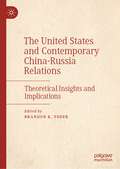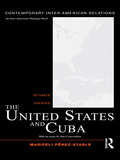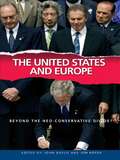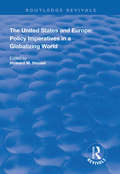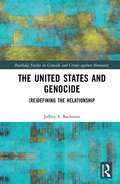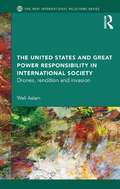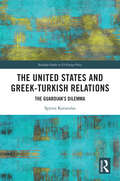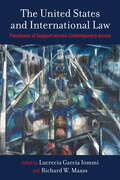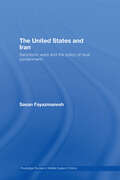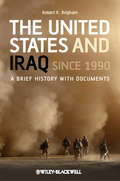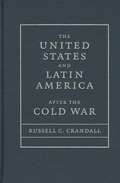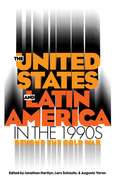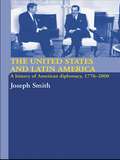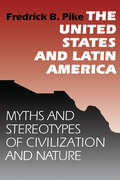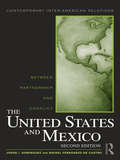- Table View
- List View
The United States Constitution: What It Says, What It Means
by Justicelearning. Org StaffAffordable, readable, and indispensable,The United States Constitution: What it Says, What it Means allows you to put the most important document in American history in your back pocket. In conjunction with Justice Learning and The Annenberg Foundation Trust at Sunnylands and with an introduction written by Caroline Kennedy and an afterword written by David Eisenhower, this pocket guide appeals to the broadest possible audience. Each Article and each Amendment is followed by a clear and concise explanation, in plain English, that is suitable for both middle and high school students. On December 8, 2004 President Bush officially signed Constitution Day into law. The law mandates that each year, on September 17th, schools and colleges that receive federal money are required to teach the Constitution. The new law was championed in Congress by Sen. Robert Byrd who famously carries around a copy of the document in his pocket. Sen. Byrd became increasingly alarmed at the lack of civics education-specifically relating to the Constitution-in our public schools and he wanted to take action. Lightweight, easy to use and easy for everyone to understand The United States Constitution: What it Says, What it Means is an excellent way for students and citizens of all ages to read and completely comprehend the building block of American democracy. Justice Learning (www. justicelearning. org), is a comprehensive on-line resource that offers wide-ranging non-partisan materials relating to civics education.
The United States Contested: American Unilateralism and European Discontent
by Sergio FabbriniWhy and how is America contested by Europe? This new book answers this question and contributes to a better understanding of contemporary transatlantic tensions. Adopting different theoretical perspectives, the leading contributors to this volume assess the European discontent with America and relate this to the unilateral turn of US foreign policy in the twenty-first century. American unilateralism is interpreted by all the authors as the expression of a new conservative nationalism which has been growing in the country since the 1970s and became culturally hegemonic after 9/11. They explore the following key areas: the rise of American conservative nationalism US foreign policy transatlantic relations anti-Americanism the Iraq War the future of American political and cultural hegemony. This book will be vital reading for students of international relations, foreign policy analysis, American and European politics.
The United States Of Trump: How The President Really Sees America
by Bill O'ReillyReaders around the world have been enthralled by journalist and New York Times bestselling author Bill O’Reilly’s Killing series—riveting works of nonfiction that explore the most famous events in history. Now, O’Reilly turns his razor-sharp observations to his most compelling subject thus far—President Donald J. Trump. In this thrilling narrative, O’Reilly blends primary, never-before-released interview material with a history that recounts Trump’s childhood and family and the factors from his life and career that forged the worldview that the president of the United States has taken to the White House. <p><p> Not a partisan pro-Trump or anti-Trump book, this is an up-to-the-minute, intimate view of the man and his sphere of influence—of “how Donald Trump’s view of America was formed, and how it has changed since becoming the most powerful person in the world”— from a writer who has known the president for thirty years. This is an unprecedented, gripping account of the life of a sitting president as he makes history. <p> As the author will tell you, “If you want some insight into the most unlikely political phenomenon of our lifetimes, you’ll get it here.”
The United States Presidents Illustrated
by Robert M. ReedThis comprehensive volume includes all 44 American presidents, from the nation's first to the most recent. Concise text highlights their lives, the times, and political climate in which they lived.
The United States and Argentina: Changing Relations in a Changing World (Contemporary Inter-american Relations Ser.)
by Deborah Norden Roberto Guillermo RussellFirst Published in 2002. Routledge is an imprint of Taylor & Francis, an informa company.
The United States and Brazil: A Long Road of Unmet Expectations
by Monica HirstThis book is a succinct overview of the history of US-Brazilian relations over the past two decades. Monica Hirst considers economic relations between the two countries, presenting pertinent statistical information and detailing key economic policy disputes between the two governments (as well as the ongoing negotiations regarding a free trade agreement for the Americas). The book also looks at political issues such as military cooperation, nuclear energy, human rights and democracy, migration, the relative influence of both governments elsewhere in South America, relations in the context of multilateral organizations, drug trafficking, terrorism and the January 2003 transition from the Cardoso to the Lula presidency. It concludes with an essay that situates US-Brazilian relations in a broader analytical and comparative framework. The United States and Brazil will be of interest to students and scholars of economics, geography and politics and international relations in general.
The United States and Central America: Geopolitical Realities and Regional Fragility
by Mark B. Rosenberg Luis G. SolisThis book is a concise overview of the recent history of U.S.-Central American relations. Part of the Contemporary Inter-American Relations series edited by Jorge Dominguez and Rafael Fernandez de Castro, it focuses on the relations between the U.S. and this region since the end of the Cold War. The volume considers economic relations between the two regions, presenting pertinent information on the Central American Free Trade Agreement (CAFTA). It also looks at political issues such as military cooperation, security issues, the drug trade and organized crime, democracy in the region, and migration. Finally, it concludes with an assessment of the direction US-Central American relations are taking at present, moving beyond the black-and-white challenges of Soviet domination in the region to address post-9/11 security concerns. The United States and Central America will be of interest to students and scholars of foreign policy, Latin American politics and politics and international relations in general.
The United States and China Since World War II: A Brief History
by Chi WangThis book surveys the complicated history of U.S.-Chinese relations. After two brief chapters providing historical context, the focus shifts to the mid-twentieth century, the wartime alliance, the war's bitter aftermath, and the decades since World War II, including the path from normalisation to China's hosting of the 2008 Summer Olympics. The author traces the ways in which the two countries have managed the blend of common and competitive interests in their economic and strategic relationships; the shifting political base for Sino-American relations within each country; the emergence and dissolution of rival political coalitions supporting and opposing the relationship; the evolution of each society's perceptions of the other; and ongoing differences regarding controversial topics like Taiwan and human rights. The author's early years in China, American education, and career as a China expert and an advisor on U.S.-China relations and cultural affairs for over fifty years, have afforded him unique opportunities to observe and participate in the development of this important relationship.
The United States and China in the Era of Global Transformations: Geographies of Rivalry
by Salvador Santino F. RegilmeOver the last two decades, China has emerged as one of the most powerful state actors in the post-Cold War international system. This book provides a multifaceted and spatially oriented analysis of how China’s re-emergence as a global power impacts the dominance of the United States as well as domestic state and non-state actors in various world-regions, including the Asia-Pacific, Africa, South America and the Caribbean, the Middle East, Europe and the Arctic. Chapters reflect on how and under which conditions competition (and cooperation) between the United States and China vary across these regions and what such variations mean for the prospects of war and peace, universal human dignity and global cooperation.
The United States and Contemporary China-Russia Relations: Theoretical Insights and Implications
by Brandon K. YoderChina and Russia have grown progressively closer over the last two decades, yielding a China-Russia “axis” uniquely capable of challenging the United States and of revising key aspects of the international order. Although the scholarly literature has offered detailed descriptions and various ad hoc explanations of this trend, the Sino-Russian bilateral relationship has been the subject of very little scrutiny using rigorous theory, which has precluded the formation of logically coherent and empirically supported explanations for increasing China-Russia cooperation. Moreover, the cooperative post-Cold War trend in the bilateral relationship is puzzling for each of the major paradigms of international relations theory: realism, constructivism and liberalism. This volume brings together leading IR scholars from various theoretical perspectives, as well as theoretically-informed experts in Chinese and Russian foreign policy. The chapters develop and apply nuanced theoretical arguments to derive testable hypotheses for the cooperative trend in China-Russia relations. In contrast to existing scholarship, the book offers generalizable insights that both improve our understanding of a crucially important contemporary case, while also advancing IR theory in substantial ways.
The United States and Cuba: Intimate Enemies
by Marifeli Pérez-StableA great power and a weaker, rival neighbor can eventually have normal relations. Prior to 1959, Cuba and the United States didn’t have a mutually beneficial and respectful relationship, and amid the Cold War, Cuba’s alliance with the Soviet Union made U.S.-Cuba normality even more elusive. What the United States and Cuba now face is relating to each other as normally as possible, a task made all the more difficult by the shadow of the Cold War. After 1989, regime change returned to the heart of U.S.-Cuba policy, a major obstacle for Washington-Havana dialogue. In turn, Cuban leaders have generally shirked their responsibility to do their part to ease the fifty-year enmity with the United States. This book systematically covers the background of U.S.-Cuban relations after the Cold War and explores tensions that extend into the twenty-first century. The author explores the future of this strained relationship under Obama's presidency and in a post-Castro Cuba.
The United States and Europe: Beyond the Neo-Conservative Divide? (Contemporary Security Studies)
by Jon Roper John BaylisA penetrating new examination of the triangular political and cultural relationship between America, Britain, and continental Europe. This relationship is both fraught and dynamic. Post-war reconstruction of Europe brought integration. Creating a ‘United States of Europe’ was a goal shared by many Americans. Yet the contemporary 'War on Terror', has redefined relationships between America, Britain, 'old' and 'new' Europe. For Britain, the Channel seems wider than the Atlantic, although geopolitically it is part of Europe. This book brings together experts from Britain, Europe and America to explore the complexities of contemporary cultural and political relationships, considering the challenges that have been met and those that have to be faced.
The United States and Europe: Policy Imperatives In A Globalizing World (Global Interdisciplinary Studies)
by Howard M. HenselThis title was first published in 2002. This provocative volume explores key aspects of the contemporary relationship between the United States and the European powers as they attempt to address common issues as the international community enters a new millennium. Representing diverse perspectives, opinions, analyses and recommendations regarding the regional and global problems and opportunities confronted by both the United States and the Europeans, the book is particularly suitable for scholars and policy makers alike who contribute to ongoing discussions concerning this critical relationship.
The United States and Fascist Italy
by Gian Giacomo Migone Molly Tambor Gian Giacomo Migone Molly TamborOriginally published in Italian in 1980, Gli Stati Uniti e il fascismo: Alle origini dell'egemonia Americana in Italia is regarded today as a crucial text on the relationship between the United States and Italy during the interwar years. Aside from the addition of two new prefaces - one by the author and one by the book's translator, Molly Tambor - the original text has remained unchanged, so that Anglophone readers now have the opportunity to engage with this classic work. By analyzing the enduring relationship between the United States - especially its financial establishment - and fascist Italy up until Mussolini's conquest of Ethiopia in 1935, this book provides answers to some key questions about the interconnectedness of America's rise to hegemonic global financial power in the twentieth century and its support of Italian fascism during this time.
The United States and Genocide: (Re)Defining the Relationship (Routledge Studies in Genocide and Crimes against Humanity)
by Jeffrey S. BachmanThere exists a dominant narrative that essentially defines the US’ relationship with genocide through what the US has failed to do to stop or prevent genocide, rather than through how its actions have contributed to the commission of genocide. This narrative acts to conceal the true nature of the US’ relationship with many of the governments that have committed genocide since the Holocaust, as well as the US’ own actions. In response, this book challenges the dominant narrative through a comprehensive analysis of the US’ relationship with genocide. The analysis is situated within the broader genocide studies literature, while emphasizing the role of state responsibility for the commission of genocide and the crime’s ancillary acts. The book addresses how a culture of impunity contributes to the resiliency of the dominant narrative in the face of considerable evidence that challenges it. Bachman’s narrative presents a far darker relationship between the US and genocide, one that has developed from the start of the Genocide Convention’s negotiations and has extended all the way to present day, as can be seen in the relationships the US maintains with potentially genocidal regimes, from Saudi Arabia to Myanmar. This book will be of interest to scholars, postgraduates, and students of genocide studies, US foreign policy, and human rights. A secondary readership may be found in those who study international law and international relations.
The United States and Great Power Responsibility in International Society: Drones, Rendition and Invasion (New International Relations)
by Wali AslamThis book evaluates American foreign policy actions from the perspective of great power responsibility, with three case studies: Operation Iraqi Freedom, American drone strikes in Pakistan and the post- 9/11 practice of extraordinary rendition. This book argues that the US invasion of Iraq in 2003, American drone attacks in Pakistan and the practice of extraordinary rendition are the examples of irresponsible actions undertaken by the U.S. acting as a great power in international society. Focusing on a major theoretical approach of International Relations, the English School, this book considers the responsibilities of great powers in international society. It points to three obligations of great powers: to act according to the norm of legality, to act according to the norm of legitimacy, and to adhere to the principles of prudence. The author applies the criteria of legality, legitimacy and prudence, to analyse the three foreign policy endeavours of the U.S., and, developing a normative framework, clarifies the implications for future U.S. foreign policy. This book will be of strong interest to students and scholars of international relations, international relations theory, American politics, foreign policy studies, international law, South Asian studies and Middle Eastern studies.
The United States and Greek-Turkish Relations: The Guardian’s Dilemma (Routledge Studies in US Foreign Policy)
by Spyros KatsoulasThis book examines the role of the United States in Greek–Turkish relations and fills an important gap in alliance theory regarding the guardian’s dilemma. The strategy of a great power involves not only tackling threats from enemies, but also dealing with problems that arise between allies. Every time Greece and Turkey threatened to go to war against each other, the United States had to effectively restrain its two strategic allies without straining relations with either one of them. This book explores how the United States responded to the guardian’s dilemma in six crises during the Cold War, pursuing a policy of dual restraint to prevent an intra-alliance conflict, mitigate the consequences of each crisis, and maintain effective control of the Rimland Bridge. From a neoclassical-realist standpoint, the book examines how the United States responded to each Greek–Turkish crisis, for what reasons, and with what results. It will be of interest to scholars of foreign policy, security studies, geopolitics, and international relations.
The United States and International Law: Paradoxes of Support across Contemporary Issues
by Lucrecia García Iommi Richard W MaassThe United States spearheaded the creation of many international organizations and treaties after World War II and maintains a strong record of compliance across several issue areas, yet it also refuses to ratify major international conventions like the UN Convention on the Law of the Sea and the Convention on the Elimination of All Forms of Discrimination Against Women. Why does the U.S. often seem to support international law in one way while neglecting or even violating it in another? The United States and International Law: Paradoxes of Support across Contemporary Issues analyzes the seemingly inconsistent U.S. relationship with international law by identifying five types of state support for international law: leadership, consent, internalization, compliance, and enforcement. Each follows different logics and entails unique costs and incentives. Accordingly, the fact that a state engages in one form of support does not presuppose that it will do so across the board. This volume examines how and why the U.S. has engaged in each form of support across twelve issue areas that are central to 20th- and 21st-century U.S. foreign policy: conquest, world courts, war, nuclear proliferation, trade, human rights, war crimes, torture, targeted killing, maritime law, the environment, and cybersecurity. In addition to offering rich substantive discussions of U.S. foreign policy, their findings reveal patterns across the U.S. relationship with international law that shed light on behavior that often seems paradoxical at best, hypocritical at worst. The results help us understand why the United States engages with international law as it does, the legacies of the Trump administration, and what we should expect from the United States under the Biden administration and beyond.
The United States and Iran: Sanctions, Wars and the Policy of Dual Containment (Routledge Studies in Middle Eastern Politics)
by Sasan FayazmaneshWhen and why did the United States policy of containment of Iran come about? How did it evolve? Where is it going? Much has been said about the US policy of dual containment, particularly as it pertains to Iraq. However, there has been little in-depth analysis of this policy when it comes to Iran. Sasan Fayazmanesh explores this often neglected subject by analyzing the history of this policy. The analysis includes the role that the Carter and Reagan Administrations played in the Iran-Iraq war, the numerous sanctions imposed on Iran by the Clinton Administration and the aggressive and confrontational policy toward Iran adopted by the George W. Bush Administration after the events of September 11, 2001. This topical read synthesises a range of primary sources, including firsthand reports, newspaper articles and electronic media, and presents a coherent analysis of the ebbs and flows in the US thinking on Iran and Iraq.
The United States and Iraq Since 1990
by Robert K. BrighamThis book offers a concise history of US policy in Iraq since 1990 and how it has evolved over two decades. Examines US relations with Iraq from both a regional and international perspective Argues that the only way to clearly understand US policy toward Iraq is to see it in its proper historical context and within a transnational framework Uses recently declassified documents at the end of each chapter to illustrate US decision-making in the wars for Iraq Addresses the importance of the changing domestic climate surrounding two decades
The United States and Latin America after the Cold War
by Russell CrandallIn this book, Crandall examines the policies of three post-Cold War presidential administrations through the prism of three critical areas: democracy, economics, and security. He argues that any lasting analysis must be viewed through a fresh framework that allows for the often unexpected episodes and outcomes in U.S.-Latin American relations.
The United States and Latin America in the 1990s
by Lars Schoultz Augusto Varas Jonathan HartlynA comprehensive examination of both unresolved tensions in inter-American relations and the specific problems facing U.S. and Latin American policymakers in the 1990s.--American Political Science Review "These well-integrated essays analyze the key issues in contemporary inter-American relations very clearly. The authors address their themes with subtlety and insight, in this first overall assessment of North-South relations in the Western Hemisphere during the post-Cold War period.--Christopher Mitchell, New York University "A superb contribution. . . . At a time when U.S.-Latin American relations face a critical turning point, policymakers would benefit from a careful reading of this fine book.--Eduardo A. Gamarra, Florida International University
The United States and Latin America: A History of American Diplomacy, 1776-2000
by Joseph SmithProviding a concise, balanced and incisive analysis of US diplomatic relations with Latin America from 1776 to the end of the twentieth century, this timely work explores central themes such as the structure of international relations, and the pursuit of American national interest by the use of diplomacy, cultural imperialism and economic and military power. Joseph Smith examines: * the rise of the USA as an independent power* its policy towards Latin-American movements for independence* the evolution of the Monroe Doctrine* pan-Americanism* dollar diplomacy* the challenge of communism. Highlighting Latin American responses to US policy over a significant time span, the study documents the development of a complex historical relationship in which the United States has claimed a pre-eminent role, arousing as much resentment as acquiescence from its southern neighbours.Including a timely discussion of the current issues of debt, trade and narcotics control, this unique and valuable study will be of interest to all those with an interest in US and Latin American international relations.
The United States and Latin America: Myths and Stereotypes of Civilization and Nature
by Fredrick B. PikeThe lazy greaser asleep under a sombrero and the avaricious gringo with money-stuffed pockets are only two of the negative stereotypes that North Americans and Latin Americans have cherished during several centuries of mutual misunderstanding. This unique study probes the origins of these stereotypes and myths and explores how they have shaped North American impressions of Latin America from the time of the Pilgrims up to the end of the twentieth century. Fredrick Pike's central thesis is that North Americans have identified themselves with "civilization" in all its manifestations, while viewing Latin Americans as hopelessly trapped in primitivism, the victims of nature rather than its masters. He shows how this civilization-nature duality arose from the first European settlers' perception that nature—and everything identified with it, including American Indians, African slaves, all women, and all children—was something to be conquered and dominated. This myth eventually came to color the North American establishment view of both immigrants to the United States and all our neighbors to the south.
The United States and Mexico: Between Partnership and Conflict
by Rafael Fernández de Castro Jorge I. DomínguezBy sharing one of the longest land borders in the world, the United States and Mexico will always have a special relationship. In the early twenty-first century, they are as important to one another as ever before with a vital trade partnership and often-tense migration positions. The ideal introduction to U.S.-Mexican relations, this book moves from conflicts all through the nineteenth century up to contemporary democratic elections in Mexico. Domínguez and Fernández de Castro deftly trace the path of the relationship between these North American neighbors from bloody conflicts to (wary) partnership. By covering immigration, drug trafficking, NAFTA, democracy, environmental problems, and economic instability, the second edition of The United States and Mexico provides a thorough look back and an informed vision of the future.
